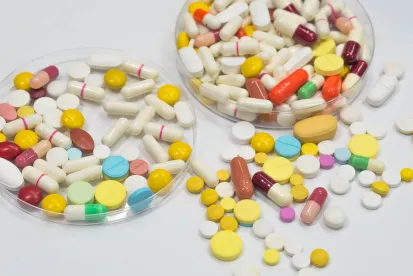In Helsinn Healthcare S.A. v. Teva Pharmaceuticals USA, Inc., the Federal Circuit found that a publicly-announced “Supply and Purchase” agreement triggered the on-sale bar under pre-AIA 35 USC § 102(b) and under AIA 35 USC § 102(a)(1). With this case, the court offered its first interpretation of the on-sale bar of the America Invents Act. Although the court did not address whether an entirely secret sale would qualify as prior art under the AIA, it decided that where the existence of the sale was made known to the public, the sale constitutes prior art even if the public disclosure did not reveal the invention.
The Patents At Issue
The patents before the court included three pre-AIA patents and one AIA patent. The pre-AIA patents were U.S. Patent Nos. 7,947,724, 7,947,725, and 7,960,424. The Court identified claim 2 of the ’725 patent as representative of the group.
- A pharmaceutically stable solution for reducing emesis or reducing the likelihood of emesis comprising:
a) 0.05 mg/mL palonosetron hydrochloride, based on the weight of the free base, in a sterile injectable aqueous carrier at a pH of from 4.5 to 5.5;
b) from 0.005 mg/mL to 1.0 mg/mL EDTA; and
c) mannitol in an amount sufficient to tonicify said solution, in a concentration of from about 10 mg/ml to about 80 mg/ml.
The AIA patent was U.S. Patent No.8,598,219. The court identified claim 1 as representative:
- A pharmaceutical single-use, unit-dose formulation for intravenous administration to a human to reduce the likelihood of cancer chemotherapy-induced nausea and vomiting, comprising a 5 mL sterile aqueous isotonic solution, said solution comprising:
palonosetron hydrochloride in an amount of 0.25 mg based on the weight of its free base;
from 0.005 mg/mL to 1.0 mg/mL EDTA; and
from 10 mg/mL to about 80 mg/mL mannitol,
wherein said formulation is stable at 24 months when stored at room temperature.
The Agreements At Issue
In April 2001, almost two years before applying for the patents, Helsinn and a third party company (MGI) entered into two agreements: (1) a License Agreement and (2) a Supply and Purchase Agreement. The agreements related to 0.25 mg and 0.75 mg doses of the palonosetron products, or for whichever of the two dosages were approved by the FDA.
The agreements were announced in a joint press release and in a filing with the Securities and Exchange Commission, which included partially-redacted copies of both agreements. However, two features of the agreements were not publicly disclosed: (1) the price terms and (2) the specific dosage formulations covered by the agreements (i.e., the 0.25 and 0.75 mg doses).
The district court found the agreements qualified as a “sale” under pre-AIA § 102(b), but did not render the pre-AIA patents invalid because the invention was not yet “ready for patenting” because FDA approval had not been obtained. With regard to the AIA patent, the district court found the agreements did not qualify as a “sale” under AIA § 102(a)(1), interpreting that statute as requiring a sale to “publicly disclose the details of the invention,” which was not the case here.
The On-Sale Bar Under Medicines Co.
(Pre-AIA 35 USC § 102(b))
The Federal Circuit decision was authored by Judge Dyk and joined by Judges Mayer and O’Malley. The court addressed whether the agreements triggered the on-sale bar under either statute, and whether the invention was sufficiently ready for patenting prior to the critical date in order for the sales to be invalidating.
With regard to the pre-AIA patents, the Federal Circuit found the Supply and Purchase Agreement to amount to an invalidating sale under pre-AIA § 102(b), applying the analytical framework established in Medicines Co. v. Hospira, Inc., 827 F.3d 1363 (Fed. Cir. 2016) (en banc). As stated by the court:
The Supply and Purchase Agreement bears all the hallmarks of a commercial contract for sale. It obligated MGI to purchase exclusively from Helsinn and obligated Helsinn to supply MGI’s requirements of the 0.25 and 0.75 mg doses if approved by FDA.
The court explained that the existence of a sale was not altered by the uncertainty as to whether the FDA would approve the 0.25 mg dose or the 0.75 mg dose, finding FDA approval to be a condition precedent to the sale. The court also explained that the agreement was not too uncertain to constitute a sale simply because it covered the 0.25 mg dose, the 0.75 mg dose, and both doses.
The court noted that it was not creating a rule that all distribution agreements constitute sales under § 102(b), but distinguished Medicines Co. along these lines:
Helsinn did not contract for MGI’s confidential marketing or distribution services as Medicines contracted for Ben Venue’s confidential manufacturing services. Instead, the Supply and Purchase Agreement between Helsinn and MGI unambiguously contemplated the sale by Helsinn of MGI’s requirements of the claimed invention.
The On-Sale Bar Under The AIA
(AIA 35 USC § 102(a)(1)
With regard to the AIA patent, the court reversed the district court and held that the Supply and Purchase Agreement met the requirements of the on-sale bar under the AIA.
After the AIA, if the existence of the sale is public, the details of the invention need not be publicly disclosed in terms of the sale” to meet the requirements of the on-sale bar.
The language of AIA 35 USC § 102(a)(1) at issue reads:
A person shall be entitled to a patent unless [] the claimed invention was patented, described in a printed publication, or in public use, on sale, or otherwise available to the public before the effective filing date of the claimed invention.
Teva and various amici argued that the AIA did not change the on-sale bar, since Congress used the same “on sale” term in AIA § 102(a)(1) that appears in pre-AIA § 102(b). On the other hand, Helsinn, the U.S. government, and other amici argued that the AIA did change the law by adding the catch-all provision, “or otherwise available to the public,” which they argued reflects back on the “on sale” clause and requires any “sale” to make the invention “available to the public.”
The court reviewed the language of the statute and legislative history alleged to support a change in the law, and concluded that there was no indication in the cited floor statements that reflected Congressional intent to change the law and overrule existing on-sale bar jurisprudence. The court therefore held:
[A]fter the AIA, if the existence of the sale is public, the details of the invention need not be publicly disclosed in the terms of sale.
Thus, even though specific details of the Helsinn invention were not made public by the announcement of the agreements, since their existence was made public the on-sale bar was triggered under AIA § 102(a)(1).
The court also reversed the district court’s “not ready for patenting” ruling, emphasizing that “[t]he completion of Phase III studies and final FDA approval are not prerequisites for the invention here to be ready for patenting, and finding “overwhelming” evidence “that before the critical date … it was established that the patented invention would work for its intended purpose.”
Avoiding Prior Art Under The AIA
Although some were hoping the AIA would do away with secret prior art, the court’s decision that the AIA did not drastically change the on-sale bar lends more predictability to this area of law. The court’s ruling on the “ready for patenting” issue is a good reminder of the tensions between filing a patent application early enough to avoid prior art but late enough to be able to provide an enabling disclosure.




 />i
/>i

